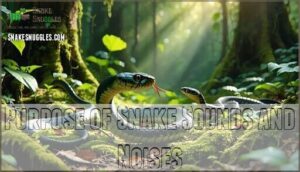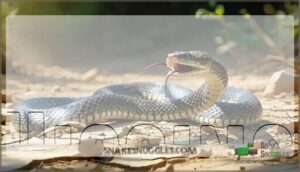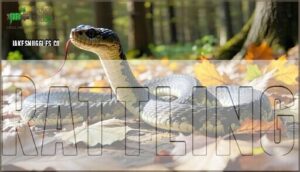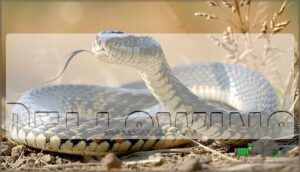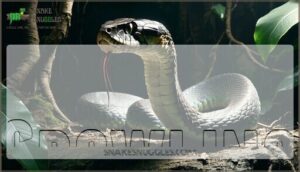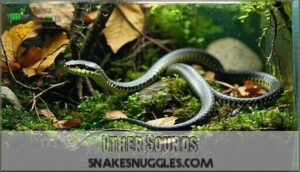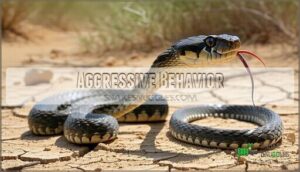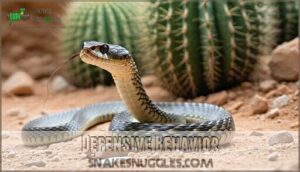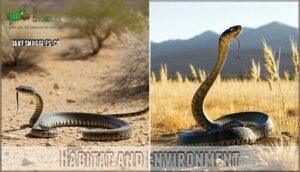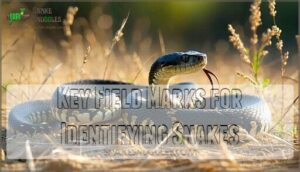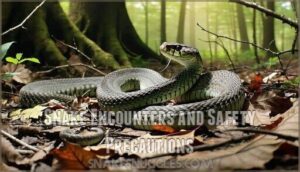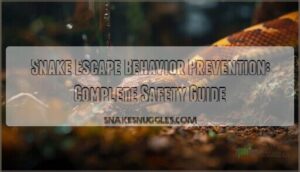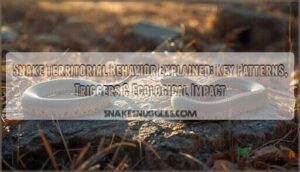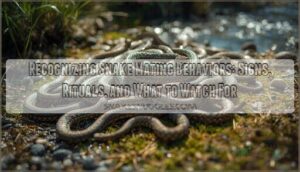This site is supported by our readers. We may earn a commission, at no cost to you, if you purchase through links.
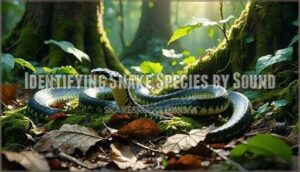
Rattlesnakes are the obvious exception—their signature rattle is like nature’s own warning bell.
Most other snakes stick to hissing, which sounds pretty similar across species.
Some larger snakes, like bull snakes, can produce surprisingly loud hisses that might fool you into thinking you’ve found a rattler.
Cottonmouths occasionally make a weird vibrating sound by rapidly shaking their tails against leaves.
While sound can offer clues about what you’re dealing with, visual identification remains your best bet for staying safe and making accurate species determinations, and it’s essential for staying safe.
Table Of Contents
- Key Takeaways
- Types of Snakes That Produce Sounds
- Purpose of Snake Sounds and Noises
- Common Snake Sounds and Noises
- Identifying Snake Species by Sound
- Snake Behavior and Body Language
- Habitat and Environment
- Key Field Marks for Identifying Snakes
- Additional Considerations for Identification
- Snake Encounters and Safety Precautions
- Snake Biology and Ecology
- Frequently Asked Questions (FAQs)
- What Sounds Does a Snake Make?
- How Do You Identify a Rattlesnake Sound?
- Why Do Snakes Make a Sss Sound?
- What Does a Snake in the Wall Sound Like?
- How can I tell what kind of snake I found?
- Can I upload a picture of a snake for identification?
- Is there an app to identify a snake?
- What is the buzzing sound snake?
- Where and When Can You Find Snakes?
- How do I tell what kind of snake I found?
- Conclusion
Key Takeaways
- You can’t reliably identify most snake species by sound alone – while rattlesnakes have their distinctive buzz, most other snakes just hiss in similar ways, making visual identification your best bet for accurate species determination.
- Listen for warning sounds and back away immediately – whether it’s hissing, rattling, or growling, these sounds mean the snake feels threatened and you’re too close, so freeze first, then slowly retreat to give them space.
- Some non-venomous snakes are excellent mimics – species like bull snakes, corn snakes, and kingsnakes shake their tails against leaves to sound like rattlesnakes, so don’t assume you’re safe just because you hear rattling.
- Combine sound clues with visual features for proper identification – use audio as your first alert, then look for key physical markers like head shape, eye type, body patterns, and scale arrangements to accurately determine what species you’re dealing with.
Types of Snakes That Produce Sounds
You’d be surprised how many snakes make sounds beyond the classic hiss or rattle.
From king cobras that growl like a big cat to bull snakes that bellow loudly, each species uses unique noises to communicate or defend itself.
Venomous Snakes
Venomous snakes have some fascinating vocal tricks to watch out for, and these sounds are your first warning to stay away.
Their unique vocalizations help with snake sound identification and understanding venom delivery behavior.
- Rattlesnakes: Masters of the unmistakable rattling sound, produced by their keratin tail segments.
- King Cobras: Intimidate with a deep growl, unmatched in snake vocalization analysis.
- Saw-scaled Vipers: Use rasping hisses, created by rubbing keeled scales together.
Each sound acts as a survival tool, signaling danger, highlighting their strike range and defensive nature.
Always listen and retreat.
Non-Venomous Snakes
Nonvenomous snakes are masters of mimicry, employing clever defensive tactics like tail-shaking to rattle leaves and sound fierce.
Corn snakes and gopher snakes often imitate rattlesnakes, fooling predators with their sound range. Bull snakes and pine snakes ramp up the theatrics, bellowing impressively when threatened.
These crafty displays showcase the incredible versatility of snake species sounds, and highlight their ability to adapt to different situations.
Learning snake acoustic identification helps you recognize the unique calls and behaviors of these harmless yet resourceful creatures across varied habitats, which is essential for understanding their unique calls.
Pet Snakes
Your pet snake mightn’t have a lot to say, but their sounds can speak volumes.
Whether it’s a harmless hiss or a faint tail rattle, these behaviors offer insight into their mood and health. Ball pythons tend to hiss when stressed, signaling unease or even a respiratory issue. Corn snakes use a soft tail rattle to mimic danger, a fascinating trait in these non-aggressive pets.
Keep an ear out for these signals:
- Hissing: Common with handling hissing snakes or during captive snake stress.
- Rattling: A subtle sound, often from corn snakes.
- Popping noises: Could indicate minor issues with breathing.
- Silent gap: Some species rarely vocalize but communicate through movement.
Understanding pet snake sounds deepens your bond and guarantees their health.
Purpose of Snake Sounds and Noises
Snake sounds aren’t random; they’ve got important jobs to do.
Whether it’s scaring off predators, warning you to back off, or chatting with a mate, every hiss, rattle, or growl serves a specific purpose.
Defense Mechanisms
Snakes are masters of self-preservation, using diverse defense mechanisms to avoid danger.
Their arsenal of snake sounds offers a symphony of cleverly adapted warnings:
- Hissing: A sharp, ominous exhale warning anything nearby.
- Rattling: A noisy, iconic percussion signaling "stay back!"
- Tail Shaking: Mimicry by non-venomous snakes to fool predators.
- Bellowing: Deep, thunderous roars from species like bull snakes.
- Growling: A rare, guttural low-pitched sound, resembling a predator’s threat.
These audible warnings, paired with posturing and strike prevention, conserve energy and help snakes stay safe.
Communication Methods
Snakes aren’t chatty like us, but they’ve a unique way of “talking.” They rely on acoustic signals, like hissing, rattling, or whistling, to get messages across.
Think of hissing as their way of saying, "Back off!" or rattling as a buzzing alarm.
Beyond sounds, snakes also communicate with vibrational cues, chemical signals, visual displays, and tactile communication.
For example, a rattlesnake’s iconic tail shake is both a sound and a vibrating cue on the ground.
Recognizing these snake vocalizations aids in snake species identification while also providing insights into their behaviors.
Mastering snake communication could even save you from a stressful surprise encounter outdoors!
Warning Signs
Snake sounds work as nature’s “stay away” alarm.
If you hear hissing or rattling, take it as a polite “leave now” message. These warning signs reveal distress and the need for space.
Here’s what they mean:
- Hissing: A sharp, loud exhale saying “back off.”
- Rattling: A rapid tail shake with repellent effectiveness.
- Louder sounds: A serious threat escalation.
- Body language adds clues: Raised heads, coiling.
- Immediate retreat: Always a safe option!
Common Snake Sounds and Noises
When snakes make sounds like hissing, rattling, or even growling, they’re not just trying to scare you—they’re communicating.
These noises are clues to their mood, species, and intentions, making it easier for you to identify what kind of snake you’re dealing with, based on their intentions.
Hissing
A snake’s hiss is like nature’s alarm clock—it’s impossible to ignore.
This sound, produced by air forced through the glottis, warns you when a snake feels cornered or stressed.
Here’s what to notice about hissing intensity and behavior:
- Sharp exhale: A quick burst or long, steady hiss.
- Defensive posture: Flattened head, raised body, ready to defend.
- Acoustic variation: From soft to startlingly loud.
- Species differences: Larger snakes pack a bigger vocal punch.
Hissing highlights a snake’s message: stay alert and keep your distance.
Rattling
When you hear that iconic buzz, chances are it’s a rattlesnake’s rattle—a fascinating product of evolution.
Made from interlocking keratin segments at the tail’s tip, the rattle produces sound through rapid vibration.
Notably, rattling isn’t exclusive to rattlesnakes. Non-venomous species like kingsnakes and fox snakes use mimicry rattling, shaking their tails against dry leaves to imitate the sound.
However, their “fake it” act lacks the same rattle frequency. Silent rattlesnakes, typically younger ones, may attempt the motion without sound.
Snake sound recognition becomes essential for safety, especially when distinguishing between actual rattlers and impressive imitators.
Bellowing
Ever come across a snake’s bellow? It’s an eerie, rumbling sound that commands attention!
Species like bull snakes, gopher snakes, and pine snakes use this as part of their intimidation tactics.
Here’s what to know:
- Bellowing Mechanics: Air flows through the vocal cord, creating a deep, resonant sound.
- Bellowing Purpose: It mimics larger predators, deterring threats.
- Acoustic Properties: A loud burst shifts into a softer, steady tone, perfect for defense.
Growling
Let’s talk about a sound that might make you stop in your tracks: growling! Certain snakes, like the iconic king cobra, can produce this unsettling noise. A king cobra’s growl, resembling a low rumbling hiss, signals serious warning vibes.
These growls ramp up based on growl intensity and are a fascinating mix of defense and communication.
- It’s triggered when threats escalate.
- Sounds similar to a "furious puppy" growl.
- Often paired with their dramatic hood expansion.
- Rarely imitates but shows fascinating growl evolution over time.
Snake sound identification just got interesting!
Other Sounds
Beyond hisses and rattles, snake sounds include fascinating and unexpected noises.
For instance, distressed snakes might release squeaks, while breathing can produce whistles, especially if they’re stressed or unwell.
Some species add to the confusion by creating buzzing sounds with their tails, a clever trick to mimic rattlesnakes.
You might also notice gurgling when a snake regurgitates food or moves air through its body.
Clicking noises, though rare, happen during feeding or defensive behavior, like an audible warning signal.
Occasionally, snakes make popping sounds, often linked to shedding or mild communication efforts.
Each of these lesser-known sounds contributes to our understanding of snake bioacoustics and enhances snake sound identification, offering clues about behaviors, species characteristics, and even stress levels.
Identifying Snake Species by Sound
You can identify snakes by paying close attention to the unique sounds they make, like a rattlesnake’s buzz or a king cobra’s growl.
Each sound acts as a clue, helping you match the noise to the species and understand its behavior.
Rattlesnake Sounds
Rattlesnake sounds are nature’s alarm bells, with each species producing distinct audio.
Their rattle mechanics involve hollow tail segments vibrating rapidly to create a buzzing that screams, “Stay back!”
Notably, rattle variation means some snakes buzz louder or softer depending on threats or habitat.
Silent rattlesnakes exist too, relying on subtle vibrations.
Through rattle evolution, this built-in defense warns predators while conserving energy.
Some clever non-venomous snakes mimic this sound, mastering rattle deception for survival.
Hissing Sounds
Hissing isn’t just noise—it’s a snake’s way of setting boundaries.
Produced through glottis mechanics, hissing sounds vary by species and mood.
Some snakes, like garter snakes, use defensive hissing to warn predators, while others mimic rivals for survival.
- Hissing Variations: Short or sustained bursts.
- Defensive Hissing: A clear "stay away" signal.
- Mimicry Hissing: Copycat tactics.
- Hissing Intensity: Mood indicator.
- Snake Sound Identification: Clues to species.
Bellowing Sounds
After hissing, bellowing takes the spotlight as one of the more dramatic snake sounds. It’s like a snake’s way of saying, “Back off!” with a booming voice.
Certain snake species, like bull snakes, gopher snakes, and pine snakes, are known for this deep, resonant sound. These bellowing snakes use their vocal cords—a rare feature among reptiles—to produce bursts of sound that can catch anyone off guard.
Here’s what makes bellowing fascinating:
- Bellowing Purpose: It’s a defensive sound designed to intimidate predators.
- Snake Species: Common in bull snakes, pine snakes, and gopher snakes.
- Sound Production: Air flows over a tensed vocal cord, creating vibrations.
- Intimidation Tactics: The sound is loud and startling, perfect for scaring threats away.
This unique acoustic behavior adds depth to snake sound identification.
Growling Sounds
Did you know some snakes can growl? It’s true! The King Cobra Growls are a fascinating example of this rare behavior.
Unlike the sharp hiss you’re used to, their growl is a low rumble, almost like a feline snarl. This Growl Intensity ramps up when the snake feels threatened, making it a powerful Threat Display.
Growling isn’t just noise—it’s communication. The Growl Purpose is clear: “Stay away!”
These sounds are produced by forcing air through the larynx, creating a unique Growl Variation that’s unmistakable.
If you’re into snake sound identification, recognizing these growls could help with snake audio classification and snake sounds recognition.
Snake Behavior and Body Language
When you’re observing snakes, their movements and posture can tell you as much as their sounds.
From a defensive coil to an aggressive strike pose, their body language is like a silent warning sign you don’t want to ignore.
Aggressive Behavior
Aggressive behavior in snakes is all about theatrics. They’re not picking fights but making sure you know they mean business.
Spot these snake warning signs:
- Raised head and neck, poised within strike distance
- Rapid flicking of their tongue, sensing every move
- Loud hissing or rattling, a clear threat display
Imagine a snake puffing up like it’s auditioning for a drama role—it’s all about intimidation. Respect the performance, give them space, and they’ll likely exit stage left without a fuss.
Defensive Behavior
When snakes feel cornered, they rely on defensive behaviors to stay safe.
These include hissing, tail-shaking, and coiling, all effective warning signs.
Some species even use mimicry tactics, pretending to be more dangerous snakes.
Their defensive postures amplify sounds like hissing, helping with threat assessment and energy conservation.
Remember, these snake warning signs aren’t aggressive—they’re survival strategies.
| Behavior | Purpose | Example Species |
|---|---|---|
| Hissing | Warning predators | Bull snake |
| Tail-shaking | Mimicry tactics | Corn snake |
| Coiling | Defensive postures | King cobra |
| Sound amplification | Threat assessment | Rattlesnake |
Mating Rituals
When it’s mating season, snakes put on quite a show.
Their reproductive behavior includes silent yet fascinating communication methods, like releasing pheromones to signal interest. Some species even use courtship sounds or subtle hisses as part of their snake mating rituals.
Here’s what you might notice:
- Males release pheromones to attract females.
- Females respond with specific signals to show readiness.
- Males perform combat dances to win mates.
- Certain species use mating calls like grunts or hisses.
Hunting Behavior
In the context of hunting, snakes are like silent ninjas.
With ambush tactics or active pursuit, they rely on their Jacobson’s organ for precise prey detection.
Their strike speed is lightning-fast, whether delivering venom or using constriction methods.
You might even hear subtle snake sounds during a hunt, like whooshing breaths or faint movements.
Observing snake hunting behavior offers fascinating insights into their world—nature’s ultimate game of hide and seek, perfected over millennia.
Habitat and Environment
You’ll find that different snake species prefer specific environments, and knowing their habitats helps you predict which sounds you might hear in various locations.
A rattlesnake’s warning buzz in desert scrubland tells a different story than a bull snake’s loud hiss echoing through prairie grasslands.
Forests and Woodlands
Forest acoustics create unique challenges for identifying snake calls through dense canopy effects and thick leaf litter.
Sound propagation gets muffled in these complex habitats, making timber rattlesnakes’ warning buzzes harder to detect.
Copperheads blend their soft hisses with rustling leaves, while clever rat snakes shake their tails against debris, mimicking dangerous rattlers.
Listen carefully – habitat complexity means you’ll need sharp ears to distinguish genuine threats from harmless woodland mimics.
Fields and Meadows
Open fields create unique meadow acoustics where snake sounds carry differently than dense forests.
Grassland vibrations travel through soil, alerting you to nearby serpents before visual contact. Rural soundscapes amplify hissing and rattling across open-field echoes, making identification easier from a distance.
Common field-dwelling species you’ll encounter:
- Garter snakes producing soft hissing in tall grass
- Prairie rattlesnakes with distinctive warning rattles
- Bull snakes creating loud bellowing sounds
- Rat snakes making gentle rustling noises
- Milk snakes mimicking rattlesnake tail-shaking behavior
Deserts and Mountains
Moving from open fields to harsher terrain, desert acoustics dramatically change how you’ll hear mountain snakes and desert species.
Altitude effects thin the air, making rattles sound sharper while hisses become quieter. Sound propagation travels differently across rocky surfaces and sand dunes.
Here’s your snake sound identification guide for these environments:
- Desert rattlesnakes produce crisp, metallic rattles that carry far in dry air
- Mountain vipers use seismic communication through ground vibrations on rocky slopes
- Sidewinders create soft scraping sounds as they navigate sand dunes.
Different snake habitats require adjusted listening techniques.
Wetlands and Swamps
Wetlands and swamps create unique swamp soundscapes where wetland acoustics carry snake sounds differently than dry habitats.
You’ll hear water moccasins splashing as they dive, while sound propagation through humid air amplifies hissing from hidden cottonmouths.
These snake habitats buzz with an amphibian chorus that can mask snake warnings.
Your snake sound identification guide becomes essential here – listen carefully between frog calls for that distinctive rattle or aggressive hiss echoing across the marsh.
Key Field Marks for Identifying Snakes
When you’re trying to identify a snake in the wild, sounds alone won’t tell the whole story—you’ll need to look at key physical features like body shape, head size, eye color, and scale patterns.
Think of these visual clues as your backup identification system when that telltale rattle or hiss doesn’t give away the species right away.
Body Type and Shape
Understanding snake anatomy becomes your detective toolkit when identifying species through sounds and visual cues.
A snake’s body type reveals its lifestyle and habitat preferences, making identification easier alongside audio clues in your snake sound identification guide.
Body proportions vary dramatically across snake species.
- Slender builds suggest arboreal hunters like green tree pythons
- Robust frames indicate ground-dwelling constrictors or vipers
- Compact bodies reveal burrowing specialists with unique vocalizations
Skeletal adaptations and body markings work together with distinctive sounds to pinpoint exact species.
Remember, combining visual body type assessment with audio identification creates the most reliable snake identification method.
Head Shape and Size
After examining body features, focus on Head Shape ID for accurate snake identification.
Triangular Heads typically signal venomous species like vipers, while Non-Venomous Heads appear more oval or rounded.
This isn’t foolproof – some harmless snakes flatten their heads when threatened, mimicking dangerous cousins.
Head size also matters: larger heads accommodate bigger prey, while narrow heads suit burrowing lifestyles.
When identifying snake species by sound and sight, head shape provides essential Venomous Signs to help you stay safe during encounters.
Eye Color and Shape
After examining head shape, you’ll want to focus on those mesmerizing eyes.
Pupil Shape reveals hunting habits – round pupils indicate day-active snakes, while vertical slits suggest nighttime prowlers.
Eye Size and Color Variation differ dramatically between species, from bright yellows to deep browns.
Vision Quality and Spectral Sensitivity help snakes detect prey and predators.
When building your snake sound identification guide, remember that eye characteristics complement audio cues for accurate snake identification of different snake species.
Scale Patterns and Colors
Beyond eye characteristics, scale patterns and colors serve as nature’s fingerprints for snake identification.
You’ll notice color variation spans from subtle earth tones to vibrant warning hues.
Scale morphology reveals keeled versus smooth textures, while camouflage patterns like diamond-shaped markings help rattlesnakes blend seamlessly into their surroundings.
Regional differences mean the same snake species might sport different colors depending on location.
Genetic influence creates fascinating variations—think coral snakes with their memorable red-yellow-black bands versus harmless mimics.
When identifying snake species, pay attention to pattern repetition and scale arrangement.
Some snakes showcase bold stripes, others display intricate checkerboard designs.
These visual cues, combined with sound identification, create a thorough toolkit for recognizing different species safely from a distance.
Additional Considerations for Identification
When identifying snakes by sound, you can’t overlook details like color patterns, tail shape, or even the anal scale structure.
Keeping a naturalist journal can help you track these traits and sharpen your identification skills over time.
Color and Pattern
Spotting snake species through their color and pattern requires sharp observation skills.
While snake sounds help identify species, visual cues provide vital backup confirmation for your snake sound identification guide.
Key visual markers include:
- Scale iridescence creates rainbow sheens that vary between species
- Camouflage types range from woodland browns to desert tans
- Pattern mimicry helps harmless snakes copy dangerous ones
Regional variation and color morphs add complexity.
Anal Scale Shape
Beyond color patterns, you’ll find the anal scale shape offers another identification clue.
This small feature at the snake’s vent appears either single or divided.
While studying snake sounds and calls, checking anal morphology adds precision to your snake species identification.
Different species variation patterns exist, and experienced herpetologists use this detail alongside audio cues for complete snake call identification guide accuracy.
| Scale Type | Common Species | Visual Appearance |
|---|---|---|
| Single | Rat snakes, kingsnakes | One undivided scale |
| Divided | Garter snakes, water snakes | Split into two parts |
Tail Shape and Length
A snake’s tail tells its own story through distinct morphological features that aid identification.
Tail shape and length reveal defensive adaptations and species variation, making your snake sound identification guide more complete.
Some species use caudal luring to attract prey, while others rely on rattling sounds.
- Length significance – Longer tails indicate arboreal species needing balance
- Tapering patterns – Gradual vs. abrupt narrowing differs between snake species
- Specialized structures – Rattles, spines, or clubs serve defensive purposes
- Proportional ratios – Tail-to-body length varies substantially across families
Naturalist Journal
After noting a snake’s tail characteristics, documenting your encounters in a naturalist journal becomes your secret weapon for mastering snake sound identifier skills.
Record field observations like hissing intensity, rattling patterns, and environmental context. Your species documentation should include habitat analysis and behavioral patterns you’ve witnessed.
Note which snake sounds match specific locations and times. These conservation notes create a personal snake sound recordings database, helping you recognize snake species faster during future encounters.
Consider using a dedicated journal for snakes to organize your observations. Your journal transforms scattered observations into identification expertise.
Snake Encounters and Safety Precautions
When you hear a snake’s hiss, rattle, or growl during an outdoor adventure, your first instinct should be to freeze and slowly back away—think of it as nature’s polite way of saying "please give me space."
Understanding these audio warning signs and knowing how to respond safely can turn a potentially dangerous encounter into just another wildlife story you’ll share around the campfire, with the key being to please give me space.
What to Do During an Encounter
Finding yourself face-to-face with a snake doesn’t have to be terrifying.
Most snake encounters are just two creatures trying to avoid each other—respect their space and they’ll respect yours.
Most snake encounters happen when people accidentally disturb them, so your reaction matters most. Here’s your game plan:
- Freeze first – sudden movements trigger defensive responses and warning signs like hissing
- Back away slowly – give the snake space to leave area naturally
- Listen carefully – snake sounds indicate stress levels and potential danger
Don’t attempt identification during encounters.
Focus on safety precautions instead. Remember, snakes provide valuable rodent control benefits, so respect their space.
Safety Precautions
Your safety’s priority when snake sounds signal danger nearby.
Smart encounter distance means staying six feet away—snakes can strike half their body length.
Wear sturdy boots and long pants for bite prevention during outdoor activities.
Professional removal beats DIY heroics every time; wildlife experts handle venomous species safely.
Snake-proof your property by sealing gaps, trimming vegetation, and eliminating rodent food sources.
Deterrents effectiveness varies, but mothballs and commercial repellents can help.
Listen for snake warnings like hissing or rattling—these sounds mean back away slowly.
Snake identification through audio cues helps you respond appropriately.
During snake encounters, freeze first, then retreat carefully without sudden movements.
Remember, professional removal is the safest option for handling venomous snakes.
First Aid and Treatment
When you’re dealing with snake encounters, quick thinking saves lives.
Bite symptoms include swelling, pain, and nausea from venom effects. Stay calm and call for medical assistance immediately.
Don’t cut or suck the wound. Clean gently for proper wound care, remove jewelry before swelling starts, and remember that antivenom use requires professional treatment.
A complete snakebite kit can provide essential tools for initial response. Your first aid knowledge and safety precautions matter most during these snake warnings.
Snake Biology and Ecology
You’ll discover that a snake’s biology directly influences the sounds it makes, from the rattle segments on a rattlesnake’s tail to the specialized larynx structures that create hissing noises.
Understanding where snakes live, what they eat, and how they reproduce gives you the context needed to interpret their vocalizations and better identify species in the wild.
Snake Classification
Understanding snake families helps you decode their acoustic secrets.
Venomous Families like vipers produce distinct rattles, while Non-Venomous Genera often mimic these sounds.
Sound Phylogeny reveals how different snake species evolved unique vocalizations.
Scientists use snake sound analysis tools to study Acoustic Morphology and Species Variation across families.
- Snake sound frequency varies between families – vipers rattle at higher frequencies
- Snake sound spectrograms show unique patterns for each taxonomic group
- Snake sound databases help researchers track acoustic evolution across species
Snake Habitat and Distribution
Across diverse landscapes, snake species create unique habitat sounds that vary by region.
Desert rattlesnakes produce different tones than forest dwellers, while urban habitats introduce new soundscapes ecology.
Climate impact affects vocal patterns—warmer areas intensify calls, cooler regions mute them.
Regional variations in snake sounds help researchers build thorough snake sound databases, revealing how environment shapes each snake species‘ acoustic signature within their specific snake habitat.
These sounds can even be recreated using specialized habitat products.
Snake Diet and Hunting
Snakes have mastered prey selection through specialized hunting strategies. Venomous species deliver precise venom effects to immobilize victims, while constrictors employ powerful constriction methods.
These dietary adaptations reflect each snake species’ unique hunting behavior.
Notably, different snake diet preferences often correlate with distinct snake sound patterns, helping you identify species through their vocalizations and snake sound identification tips during feeding encounters.
Snake Reproduction and Life Cycle
Beyond hunting behaviors, you’ll find snake reproduction follows fascinating patterns.
Mating rituals often involve intricate courtship dances and specific snake sound variations that attract partners.
After egg laying or live birth, the gestation period varies by species.
The hatching process produces independent young who enter the juvenile stage with instinctive survival skills, including distinct snake sound patterns for defense.
Frequently Asked Questions (FAQs)
What Sounds Does a Snake Make?
You’ll hear snakes produce hissing sounds by forcing air through their glottis, rattling from specialized tail segments, growling like king cobras, and rasping when scales rub together during movement.
How Do You Identify a Rattlesnake Sound?
Contrary to popular belief, you’ll recognize a rattlesnake’s warning long before seeing it.
The distinctive buzzing rattle sounds like maracas or dried beans shaking—unmistakable and urgent, demanding you back away immediately.
Why Do Snakes Make a Sss Sound?
You’ll hear that distinctive "sss" sound when snakes force air through their glottis as a warning.
It’s their way of saying "back off" without wasting energy on a fight they’d rather avoid.
What Does a Snake in the Wall Sound Like?
You’ll hear subtle scratching, sliding, or slithering sounds as scales scrape against drywall or wood.
Listen for soft rustling movements, especially at night when they’re most active hunting for rodents in wall cavities.
How can I tell what kind of snake I found?
Look at the head shape, eye type, and tail end first.
Triangular heads and elliptical eyes suggest venomous species.
Check for rattles, distinctive patterns, and body size.
When in doubt, keep your distance and contact wildlife experts.
Can I upload a picture of a snake for identification?
When Sarah spotted a coiled snake in her garden, she snapped a photo before backing away.
You can’t upload images here, but wildlife apps like iNaturalist or Seek let you identify snakes from photos instantly.
Is there an app to identify a snake?
Yes, several apps can help you identify snakes.
Try iNaturalist, Seek, or SnakeID for photo-based identification.
These apps use AI to analyze snake features and provide species information, safety tips, and expert community support, including safety tips.
What is the buzzing sound snake?
The buzzing sound you’re hearing likely comes from an Eastern Massasauga rattlesnake. Unlike traditional rattlesnakes, they produce a distinctive buzzing noise when threatened instead of the classic rattle sound.
Where and When Can You Find Snakes?
Like needle in a haystack, you’ll find snakes everywhere—backyards, forests, deserts, wetlands.
They’re most active during warm months, especially spring through fall.
You’ll spot them basking in sunlight or hunting at dawn and dusk.
How do I tell what kind of snake I found?
Look for key features: head shape, eye type, body patterns, and tail characteristics. Listen for sounds like hissing or rattling. Check for triangular heads and elliptical eyes in venomous species.
Conclusion
Sound serves as a starting point for identifying snake species by sound, but it’s just one piece of the puzzle.
While rattlesnakes announce themselves clearly and bull snakes deliver booming hisses, most species sound remarkably similar.
You’ll get much better results combining audio clues with visual identification—noting body shape, head size, and scale patterns.
Remember, even experienced herpetologists rely on multiple identification methods, and when you’re out exploring, let sound guide your attention, but always trust your eyes for accurate species determination and safety.
When identifying snakes, it’s crucial to consider that visual identification is key, as it helps in distinguishing between similar species.
- https://www.journals.uchicago.edu/doi/abs/10.1086/377052
- https://pubmed.ncbi.nlm.nih.gov/10441081/
- https://www.jstor.org/stable/1565572?seq=1
- https://www.mentalfloss.com/article/68816/6-sssecrets-snake-sound-scientissst
- https://www.reddit.com/r/Damnthatsinteresting/comments/1i3ut1l/unlike_other_species_of_snake_that_hiss_king/

